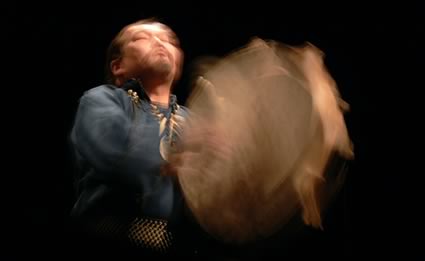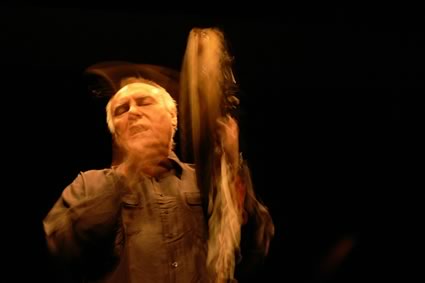Shamanism and Music
Shamanistic singer Stepanida Borisova from Sakha/Siberia
Shamanic music in Sakha Siberia (Yakutia)
What is Shamanism?
Post-Shamanic Traditions by Dean Edwards
Shamanism
is classified by anthropologists as an archaic magico-religious phenomenon in which the shaman is the great master of ecstasy. Shamanism itself, was defined by the late Mircea Eliade as a technique of ecstasy.
A shaman
may exhibit a particular magical specialty (such as control over fire, wind or magical flight). When a specialization is present the most common is as a healer. The distinguishing characteristic of shamanism is its focus on an ecstatic trance state in which the soul of the shaman is believed to leave the body and ascend to the sky (heavens) or descend into the earth (underworld). The shaman makes use of spirit helpers, with whom he or she communicates, all the while retaining control over his or her own consciousness. (Examples of possession occur, but are the exception, rather than the rule.) It is also important to note that while most shamans in traditional societies are men, either women or men may and have become shamans.

Gendos Chamzyryn © Photo by Hubl Greiner
There are a number
of relatively common practices and experiences in traditional shamanism which are being investigated by modern researchers. While the older traditional practices are ignored by some researchers, others have begun to explore these older techniques. The emergence of the new field of the 'anthropology of consciousness' and the establishment of Transpersonal Psychology as a "Fourth Force" in psychology have opened up the investigation of research into the nature and history of consciousness in ways not previously possible. Outside of academic circles a growing number of people have begun to make serious inquiries into ancient shamanic techniques for entering into altered states of consciousness.
Traditional shamans
developed techniques for lucid dreaming and what is today called the out-of the-body experience (oobe). These methods for exploring the inner landscape are being investigated by a wide range of people. Some are academics, some come from traditional societies and others are modern practitioners of non-traditional shamanism or neo-shamanism.
Along with these techniques,
the NDE or near-death-experience have played a significant role in shamanic practice and initiation for millenia. There is extensive document- ation of this in ethnographic studies of traditional shamanism. With this renewed interest in these older traditions these shamanic methods of working with dreams and being conscious and awake while dreaming are receiving increased attention. (Additional information about the out-of-body experience may be found in Jouni Smed's faq alt.out-of-body FAQ.)
The ability
to consciously move beyond the physical body is the particular specialty of the traditional shaman. These journeys of Soul may take the shaman into the nether realms, higher levels of existence or to parallel physical worlds or other regions of this world. Shamanic Flight, is in most instances, an experience not of an inner imaginary landscape, but is reported to be the shamans flight beyond the limitations of the physical body.
As noted in this article,
the Call to shamanize is often directly related to a near death experience by the prospective shaman. Among the traditional examples are being struck by lightening, a fall from a height, a serious life-threatening illness or lucid dream experiences in which the candidate dies or has some organs consumed and replaced and is thus reborn. Survival of these initial inner and outer brushes with death provides the shaman with personal experiences which strengthen his or her ability to work effectively with others. Having experienced something, a shaman is more likely to understand what must be done to correct a condition or situation.

Ken Hyder © Photo by Hubl Greiner
Post-Shamanic
While shamanism may be readily identified among many hunding and gathering peoples and in some traditional herding societies, identifying specific groups of individuals who might be called shamans is a difficult task in more stratified agricultural and manufacturing based societies. A society may be said to be Post- Shamanic when there are the presence of shamanic motifs in its traditional folklore or spiritual practices indicate a clear pattern of traditions of ascent into the heavens, descent into the netherworlds, movement between this world and a parallel Otherworld, are present in its history. Such a society or tradition may have become very specialized and recombined aspects of mysticism, prophecy and shamanism into more specialized or more 'fully developed' practices and may have assigned those to highly specialized functionaries. When such practices and functionaries are present or have teplaced the traditional shamans found in historical or traditional shamanism the use of Post-shamanic is appropriate.
Dean Edwards (deane@netcom.com) August, 1995
More specifically,
a society may be said to be Post-Shamanic when at least 6 of the following 8 conditions have been met:
- a. Shamanic ecstasy is still present, but light trance techniques are also used to access the Otherworld.
- b. Agriculture and some forms of manufacturing/crafts have replaced hunting and gathering as the primary basis for the economic life of the community.
- c.The society has developed a highly stratified social structure and very specialized occupations.
- d. Religion and spiritual methodology has become more fully developed and can no longer be properly referred to as 'archaic'. This is expecially important for rituals, ceremonies and ecstatic techniques which had traditionally been the domain of the shamans.
- e. Mystical ecstasy and unitive visions have become at least as important esoteric experiences and doctrines as shamanic ecstasy, ascension and descent in the religious and spiritual life of the community.
- f. The shaman is no longer the primary escort for the souls of the dead into their place in the next world (psychopomp). This role generally either passes onto the priestcraft or clergy to perform through ritual, is an object of individual or group prayer, or is beleived to be done by gods of guardian spirits, angels or demons.
- g. A professional clergy is present which regulates the religious life of the community.
- h. Other forms of healing, divining and counseling are present have replaced shamans as the primary source of such services.
Post-shamanic
motifs are found among many Indo-Eruopean, Asian, African and some native peoples of North America. The use of Post-Shamanic as a term makes examination of these parallel traditons and possible survivals of earlier shamanic traditions easier.
What is the origin of the word 'shaman'?
Shaman comes from the language of the Tungus of North-Central Asia. It came into use in English via Russian.
What are the usual roles of a shaman?
In contemporary, historical or traditional shamanic practice the shaman may at times fill the role of priest, magician, metaphysician or healer. Personal experience is the prime determinant of the status of a shaman. Knowledge of other realms of being and consciousness and the cosmology of those regions is the basis of the shamanic perspective and power. With this knowledge, the shaman is able to serve as a bridge between the mundane and the higher and lower states. The shaman lives at the edge of reality as most people would recognize it and most commonly at the edge of society itself. Few indeed have the stamina to adventure into these realms and endure the outer hardships and personal crises that have been reported by or observed of many shamans.
What is a Shaman?
Webster defines "Shaman" as simply a religious man. The word Shaman
comes from eastern Siberia (the Tungus Tribe) an area where shamanism
was the most prominent and where its origins may be found. Translated,
shaman means "to heat up; to burn; to work with heat and fire." The essential characteristics of Shamans are mastery of energy and
fire as a medium of transformation.
Tribal peoples believed that the Shaman was a healer and keeper of tribal history (handed down through the oral tradition) and a "Walker Between Winds." The latter term refers to the Shaman's ability to send his spirit to walk with the ancestors between the winds. To walk between the winds one has to look around the edge of reality to the paths between space. There is where the spirits of the ancestors walk the trails of time.
Amari Magdalena, Founder of the Institute for Shamanic Synthesis lived in New Mexico between 1990 and 1993. During her stay she had the privilege of working with a Toltec Nagual, don Miguel Angel Ruiz; Elena Avila a Mestizo Curandera; and Garthenia E'star a Celtic/Cherokee Shaman.
In 1996, Amari founded the Institute for Shamanic Synthesis to provide tools for achieving inner and outer peace. Institute for Shamanic Synthesis course materials represent a cross-cultural composite of Magdalena's studies, readings and intuitive guidance. The Institute for Shamanic Synthesis does not ascribe special powers to Shamans but believes that they have simply been willing to suspend their material beliefs to experience levels of reality that we could all access were we willing and able to follow their daring. At some level, today's ministers are Shamans of Western culture.
But this is not an exclusive practice nor is it limited to religious persons. Shamanism can be practiced in your everyday life to enhance the Earth Dance that each of us is here to perform.. Shamanic practice builds a bridge between your inner and outer worlds. There are many books and bodies of thought presented on Shamanism today. Two distinct paths seem to emerge from these offerings: The Path of the Heart with an emphasis on individuated healing, integration and empowerment leading to service; and, the practice of Sorcery focused on acquiring powers over others.
The Institute of Shamanic Synthesis subscribes solely to The Path of the Heart. Instructors and students, beyond the beginning class, take and oath of intention to state their plans to use the tools of Shamanism for the greatest common good.
Amari Magdalena, Founder/Director
Institute for Shamanic Synthesis
PMB336 5114 Balcones Woods Dr Ste 307
Austin TX 78759 USA
512-527-0542
Shamanistic singing from Sakha / Siberia
(Live Concert in Beirut/Lebanon with shamanistic singer Stepanida Borisova from Yakutsk/Siberia, Hubl Greiner, Mohamed Badawi & Roman Bunka at Al Bustan Festival 2008).
CD: HULU PROJECT, TranceSiberia
Shamanistic singing with Stepanida Borisova / Siberia
No. 3 at World Music Charts Europe 2001
Nominated "Best of WMCE 2001"
Intensive interpretation of shamanistic singing from Sakha (Siberia),
combined with todays western club-culture.
More at: TranceSiberia
Article: Improvised Music and Siberian Shamanism
..performance is special: normal rational processes would interfere with
it. The language of subjectivity used by musicians protects against such
interference. But it can also be read as making explicit the parallel
between improvised performance and certain types of religious experience. By Tim Hodgkinson
Read
article: Improvised Music and Siberian Shamanism

